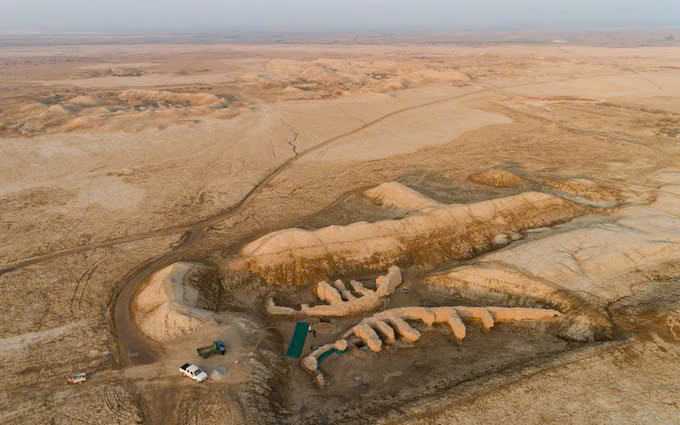The ancient city of Girsu, located in what is now Iraq’s Dhi Qar Governorate, holds within its bounds a striking symbol of Sumerian brilliance – the Bridge of Girsu. This remarkable structure, once mistaken for a temple or a dam, is recognized today as one of the oldest bridges in human history. It spanned a canal that was vital to the life and prosperity of the Mesopotamian civilization that once thrived there. The discovery and understanding of this bridge shed light not only on Sumerian technological ingenuity but also on their deep spiritual and cultural values, which continue to captivate scholars and history enthusiasts alike.

The engineering expertise demonstrated in the construction of the Bridge of Girsu is a testament to the advanced capabilities of ancient Mesopotamian civilizations. The canal it traversed measured an impressive 100 feet in width. However, at the point where the bridge crossed, the width narrowed to just 12 feet. This was not a coincidence or a product of chance; rather, it was a deliberate design decision that reflects the Sumerians’ sophisticated understanding of hydraulic engineering. The ability to manipulate the flow of water was essential for maintaining the agricultural foundation of their society. By narrowing the canal at this specific juncture, the Sumerians could effectively manage water levels and flow, ensuring that their crops received the necessary irrigation to flourish. This level of precision and foresight highlights their mastery in harmonizing nature with human needs.
However, the significance of the Bridge of Girsu extends far beyond its function as a practical structure. It is also a powerful example of how the Sumerians seamlessly intertwined their technological achievements with their spiritual beliefs. Inscriptions found on the bricks of the bridge indicate that it was dedicated to Ningirsu, the Sumerian deity associated with storms and agriculture. This dedication elevates the bridge from being merely a tool for transportation to a monument with profound spiritual meaning. Under the reign of Ur-Ningirsu, the bridge served as more than a physical crossing point. It became a symbolic connection between the earthly realm and the divine, embodying the belief that infrastructure could serve both practical and spiritual purposes.
The materials and methods used to construct the Bridge of Girsu reveal the extraordinary architectural skills of the Sumerians. Built over four millennia ago, the bridge’s durability and longevity speak to the careful selection of materials and the meticulous design process employed in its construction. The structure was not just a means of crossing the canal; it was a vital artery for trade, communication, and cultural exchange. Communities relied on this bridge to facilitate interactions that enriched their social and economic lives. The Sumerians’ ability to create infrastructure that could endure the test of time underscores their foresight and resourcefulness as builders and planners.
The cultural importance of the Bridge of Girsu is evident in its role as both a functional and a spiritual structure. It provides modern researchers with a window into the sophisticated and multifaceted world of ancient Sumer. This bridge reveals a society that valued practicality as much as it revered its gods. For the Sumerians, building infrastructure was not a purely utilitarian task; it was an act of devotion and a way to align their earthly endeavors with divine will. The inscriptions and other artifacts associated with the bridge offer valuable insights into Sumerian daily life, their technological capabilities, and their spiritual beliefs. Through this lens, the bridge becomes a powerful symbol of how the Sumerians viewed their relationship with the environment, the divine, and each other.
Today, the Bridge of Girsu stands as a tangible link to one of humanity’s earliest civilizations. It connects us not only to the past but also to the innovative spirit and deep spirituality of the Sumerians. This ancient structure serves as a reminder of how early humans shaped the foundations of civilization through their ingenuity and devotion. It also underscores the interconnectedness of their practical needs and spiritual aspirations, offering lessons that remain relevant even in modern times.
The ongoing study of the Bridge of Girsu continues to reveal new layers of understanding about the Sumerians and their world. Researchers have been able to piece together details about their engineering techniques, their religious practices, and the ways in which they organized their society. Each discovery enriches our appreciation for the remarkable accomplishments of this ancient civilization. The bridge is not just a relic of the past; it is a testament to the enduring legacy of human creativity and determination.
The Bridge of Girsu is more than a structure; it is a bridge across time. It allows us to connect with the minds and hearts of a people who lived thousands of years ago, yet whose achievements continue to inspire us today. Their ability to blend technical skill with spiritual devotion is a hallmark of their civilization and a reminder of the extraordinary potential of human ingenuity. By studying this bridge, we not only gain insights into the past but also find inspiration for the future, as we seek to build our own bridges between the practical and the profound, the earthly and the divine.





